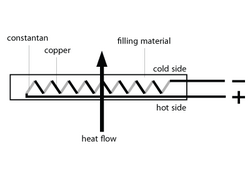Heat flow sensor
A heat flow sensor uses the Seebeck effect to generate an electrical signal proportional to the heat flow through its surface. In order to be able to carry out these measurements without knowledge of the thermal conductivity / thermal resistance, the heat flow sensors must be calibrated after production. The heat flow density results from the measured heat flow per area of the sensor. Different types of heat transfer, such as convection , heat conduction and radiation can be measured in this way. Other possible heat flow sensors are Gardon meters, thin-film thermopiles, and Schmidt-Boelter meters. The SI unit of heat flux is watts , and that of heat flux density is watts per square meter.
application
Heat flow sensors can be used for a variety of applications. Promising areas are quality analyzes of building insulation or the determination of thermal properties of textiles with the help of the heat transfer coefficient . Other possible applications include measuring flows in liquids, measuring temperatures using non-invasive methods, and measuring laser power.
Application in building physics
Every day large amounts of energy are used to heat and cool buildings, many of which are insufficiently thermally insulated and do not meet modern standards. In this regard, it is important, with the help of a heat flow sensor, to determine the quality of thermal insulation of buildings and the heat transfer coefficient.
According to the law of heat transfer , the heat flow through a surface, e.g. B. that of a building wall, directly proportional to the difference between the inner and outer surface temperature of the object (or ambient temperature). This proportionality factor is called the heat transfer coefficient or U-value . The smaller the U-value, the better the thermal insulation.
Application in the textile industry
The heat flow is an important parameter in the development of textiles with special thermal properties, such as sportswear or fire protection clothing. By using a heat flow sensor, the thermal transmission coefficient can be determined. It represents a processing and material property.
properties
A heat flow sensor measures the local heat flow density in one direction. The result is given in [W / m 2 ]. The calculation is made with the following formula.
is the output signal of the sensor and is the calibration constant, this is sensor-specific.
As Figure 1 shows, heat flow sensors usually have a flat plate shape and can measure heat flows normal to the sensor surface.
In the heat flow sensors, thermocouples are connected in series and used as thermopiles. The advantage of these thermopiles is their stability, a low ohmic value (low susceptibility to electromagnetic interference), good signal-to-interference ratio and the fact that no input generates no output.
Individual evidence
- ^ R. Gardon: An instrument for the direct measurement of intense thermal radiation. In: Rev. Sci. Instrum. 24, 1953, pp. 366-370.
- ^ TE Diller: Advances in Heat Transfer. Volume 23, Academic Press, 1993, pp. 297-298.
- ^ CT Kidd, CG Nelson: How the Schmidt-Boelter gage really works. In: Proc. 41st Int. Instrum. Symp. ISA, Research Triangle Park, NC 1995, pp. 347-368
- ↑ ZhengYu Hu: “Clean” heat flux sensor for ash fouling monitoring. (PDF) Retrieved June 23, 2016 .
- ↑ Reto Niedermann et al .: Prediction of human core body temperature using non-invasive measurement methods . In: International Journal of Biometeorology . tape 58 , no. 1 , June 13, 2013, ISSN 0020-7128 , p. 7-15 , doi : 10.1007 / s00484-013-0687-2 .
- ↑ High-precision thermal sensors for laser power detection and heat flux measurements. In: waldytech.com. Retrieved June 22, 2016 .
- ^ U-Value Measurement instead of U-Value Calculation. In: U-Value and Building Physics. Retrieved June 22, 2016 .
- ↑ U-Value Measurements with greenTEG's U-Value Kit. greenTEG AG Switzerland: Thermal Sensing & Energy Harvesting, December 1, 2015, accessed on June 22, 2016 .
- ↑ Zeinab S. Abdel-Rehim et al .: Textile Fabrics as Thermal Insulators . In: Autex Research Journal . tape 6 , no. September 3 , 2006 ( autexrj.com [PDF; accessed June 23, 2016]).





